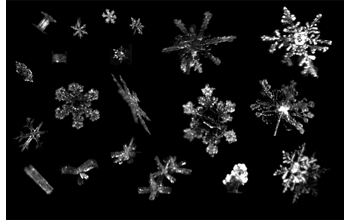Multimedia Gallery
Snowflakes that are ice crystals formed by condensation in the air
A variety of snowflakes that are simply ice crystals formed by condensation in the air. These images were taken using a new high-speed, three-camera system.
More About This Image
Tim Garrett, an associate professor of atmospheric sciences at the University of Utah who developed the camera, is taking the first automated, high-resolution images showing the complexity of snowflakes in free-fall, while measuring how fast they fall, and is collecting vast amounts of data that can be used in obtaining more accurate and representative characterizations of snow in clouds. The new camera system is called the Multi-Angle Snowflake Camera (patent pending).
Traditional photos of snowflakes are usually of rare, perfectly symmetric, six-sided snowflakes photographed in a controlled environment under a microscope. But Garrett says that snow is almost never a single, simple crystal. For example, snowflakes can have riming, where millions of water droplets collide with a snowflake and freeze on its surface, creating a little ice pellet called a "graupel." Or snowflakes may collide with other snowflakes, together forming something fluffier called an "aggregate."
The purpose of the research is to improve computer simulations of falling snow and how it interacts with radar, which could improve the use of radar in weather and snowpack forecasting and reveal more about how snowy weather can degrade microwave (radar) communications. Development of the camera was supported in part by the National Science Foundation (under grant ATM 1127692).
To learn more, see the University of Utah news story Snowflakes falling on cameras: New device reveals what snow looks like in midair. (Date of Image: 2012-2013)
Credit: Tim Garrett, University of Utah
Images and other media in the National Science Foundation Multimedia Gallery are available for use in print and electronic material by NSF employees, members of the media, university staff, teachers and the general public. All media in the gallery are intended for personal, educational and nonprofit/non-commercial use only.
Images credited to the National Science Foundation, a federal agency, are in the public domain. The images were created by employees of the United States Government as part of their official duties or prepared by contractors as "works for hire" for NSF. You may freely use NSF-credited images and, at your discretion, credit NSF with a "Courtesy: National Science Foundation" notation.
Additional information about general usage can be found in Conditions.
Also Available:
Download the high-resolution JPG version of the image. (444 KB)
Use your mouse to right-click (Mac users may need to Ctrl-click) the link above and choose the option that will save the file or target to your computer.

 All images in this series
All images in this series